This set of Heat Transfer Operations Questions and Answers for Entrance exams focuses on “Evaporators – Heat Transfer Coefficients”.
1. If the evaporator operates at very high liquid velocity so that the boiling occurs at the top end of the tube, which one of the following correlation can be used?
a) hiD ⁄ Kpure = 0.003 Re0.8 Pr0.4
b) hiD ⁄ Kpure = 0.027 Re0.8 Pr0.4
c) hiD ⁄ Ksolution = 0.0278 Re0.8 Pr0.4
d) hiD ⁄ Ksolution = 0.003 Re0.8 Pr0.4
View Answer
Explanation: If the evaporator operates at a higher velocity and the boiling occurs at the top of the tube, then the equation we must use is hiD ⁄ Ksolution = 0.0278 Re0.8 Pr0.4 and not Sieder tate as the working conditions are different for heat exchangers.
2. If the evaporator operates at very high liquid velocity so that the boiling occurs at the top end of the tube, then we use the given relation.
hiD ⁄ K=0.0278 Re0.8 Pr0.4
What is the term K here?
a) Solution thermal conductivity
b) Solvent thermal conductivity
c) Wall thermal conductivity
d) Film thermal conductivity
View Answer
Explanation: If the evaporator operates at a higher velocity and the boiling occurs at the top of the tube, then the equation we must use is hiD ⁄ Ksolution = 0.0278 Re0.8 Pr0.4, where K is the Solution Thermal Conductivity. We do not use Sieder tate equation because the working conditions are different than heat exchangers.
3. The heat transfer coefficient for rising film and falling film evaporators is same because they can be used in the same setup.
a) True
b) False
View Answer
Explanation: The setup of rising film and falling film might be the same but the film orientation is different for both the setups and hence the heat transfer coefficients too.
4. If the Reynold’s number is 24000 and the Prantl number = 4.70. Then what is the value of Nusselt number?
a) 164.8
b) 164.0
c) 163.8
d) 165.2
View Answer
Explanation: we use the formula, Nu=0.0278 Re0.8 Pr0.4=0.0278×(24000)0.8×(4.7)0.4=164.8.
5. Which one of the following is the correct temperature profile in an evaporator?
a) 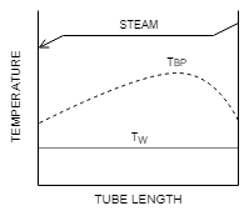
b) 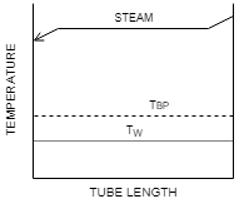
c) 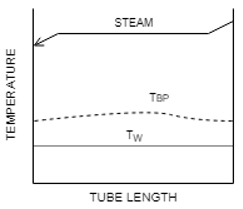
d) 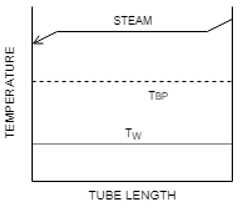
View Answer
Explanation: The Temperature of the fluid increases as it goes through the evaporator owing to the increasing concentration and superheated steam usage. Hence the temperature reaches a maximum at the steam entry point or the feed exit point.
6. In the given formula for overall heat transfer coefficient in Rising film evaporators, What is the term hOD?
\(\frac{1}{U}=\frac{1}{ho}+\frac{1}{h_{OD}}+(\frac{Do}{Di})(\frac{1}{h_{ID}})+ (\frac{Do}{Di})(\frac{1}{hi})\)
a) Outside dirt coefficient
b) Inside dirt coefficient
c) Outside film heat transfer coefficient
d) Inside film heat transfer coefficient
View Answer
Explanation: The given equation represents the overall heat transfer coefficient of a rising film evaporator under the condition of fouling and hence the terms hID is inside dirt factor and hOD as the outside dirt factor.
7. Find the value of Residence time if we have a feed of 30kg/hr at 25℃ and with evaporator consumption as 10kg/hr?
Evaporator Volume = 5L
Latent heat of vaporization of water = 2,260 kJ/kg
Specific heat capacity = 6 KJ/Kg K
Average density of solution = 1.2Kg/L
a) 0.2hr
b) 0.3hr
c) 0.4hr
d) 0.5hr
View Answer
Explanation: The mass flow rate = 30kg/hr, hence the volume flow rate = 30/1.2 = 25L/hr. Thus, as the volume of the evaporator is 5L, residence time = 5/25 = 0.2hr.
8. When the flow velocity of the fluid increases the temperature plot maxima shifts towards __________
a) Steam exit
b) Middle of the tube
c) Feed inlet
d) Feed exit
View Answer
Explanation: As the flow velocity of the fluid increases, the liquid temperature reaches its maxima when the liquid is about to leave hence the maxima is at the feed exit. At higher velocity the temperature raise is less and the liquid boils near the top of the tube.
9. The liquid temperature in the tubes increases up to certain height and then the temperature decreases due to ___________
a) Loss of superheat
b) Loss of pressure
c) Concentration increase
d) Concentration decrease
View Answer
Explanation: As the liquid reaches its final stage in the evaporator, its concentration is so high that is hardly releases any vapour and hence its temperature decreases. The steam too has by then condensed completely.
10. What is the real temperature driving force of the evaporator in the given diagram?
a) TBP – Tw
b) TW – TBP
c) TW – Tsteam
d) Tsteam – TBP
View Answer
Explanation: The real temperature driving force is Tsteam – TBP because Tw is just the pure water boiling point which is not involved in the process, rather the temperature of steam and fluid is all that is of design concern.
11. Which one of the following axes representation is correct?
a) 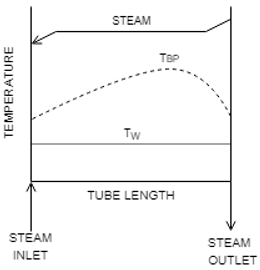
b) 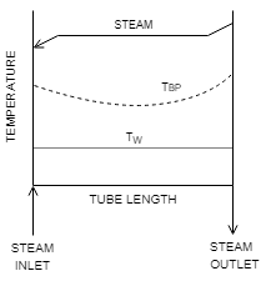
c) 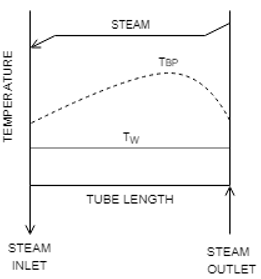
d) 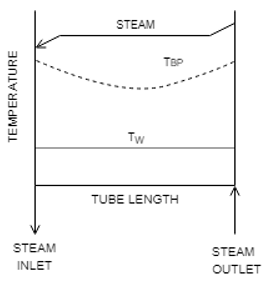
View Answer
Explanation: The Temperature of the fluid increases as it goes through the evaporator owing to the increasing concentration and superheated steam usage. Hence the temperature reaches a maximum at the steam entry point or the feed exit point. The steam enters from the region where the feed exits hence the given diagram is the robust representation.
12. When the flow rate of the fluid decreases the temperature plot shifts towards __________
a) Steam exit
b) Middle of the tube
c) Feed inlet
d) Feed exit
View Answer
Explanation: As the flow velocity of the fluid decreases, the liquid temperature reaches its maxima when the liquid is at about the middle of the tube hence the maxima is at the middle little bit near the steam inlet. At higher velocity the temperature raise is less and the liquid boils near the top of the tube.
Sanfoundry Global Education & Learning Series – Heat Transfer Operations.
To practice all areas of Heat Transfer Operations for Entrance exams, here is complete set of 1000+ Multiple Choice Questions and Answers.
If you find a mistake in question / option / answer, kindly take a screenshot and email to [email protected]
- Check Chemical Engineering Books
- Apply for Chemical Engineering Internship
- Practice Chemical Engineering MCQs
- Check Heat Transfer Operations Books
